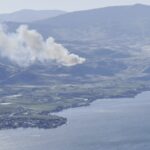Creeping silently through the steel bulkheads of Canada’s aging naval fleet, an insidious adversary has emerged—not from foreign waters, but from within. Mould infestations aboard Royal Canadian Navy frigates have reached concerning levels, triggering alarm among military officials and health experts alike as the problem threatens both operational capacity and sailor wellbeing.
The Halifax-class frigates, the backbone of Canada’s naval forces, have been battling persistent mould issues for years, according to internal documents obtained through access to information requests. These vessels, commissioned in the 1990s and now well beyond their projected 25-year service life, face deteriorating environmental conditions that create perfect breeding grounds for various fungal species.
“These aren’t just cosmetic concerns,” explains Commander James Thornton, who oversees fleet maintenance operations. “We’re dealing with structural issues that allow moisture to penetrate areas where it previously couldn’t reach. When combined with aging ventilation systems and the challenging maritime environment, you have ideal conditions for mould propagation.”
Health reports indicate that exposure to shipboard mould has contributed to respiratory complaints among crew members, with documented cases of allergic reactions, persistent coughs, and exacerbated asthma symptoms. Medical personnel have recorded a 23% increase in respiratory-related sick bay visits across the fleet compared to five years ago.
The Department of National Defence has allocated $14.6 million for immediate remediation efforts while acknowledging the challenge represents a significant maintenance hurdle. These emergency funds will address the most severely affected vessels, but naval engineers suggest a more comprehensive approach is needed.
“We’re applying specialized antimicrobial coatings and installing dehumidification systems throughout affected vessels,” said Dr. Samantha Reid, an environmental engineer consulting with the navy. “However, these are essentially sophisticated band-aids on a problem that requires fundamental reconsideration of how we maintain aging vessels in modern operational conditions.”
The timing couldn’t be worse for Canada’s military leadership, as the navy already faces significant recruitment challenges and equipment shortages. With several frigates requiring extended periods in dry dock for remediation, Canada’s maritime capabilities face potential constraints at a time of increasing global tensions.
Internal assessments from the Department of National Defence estimate that addressing the full extent of the mould problem across the fleet could cost upwards of $75 million and potentially sideline multiple vessels for months. This comes as Canada continues to participate in international maritime security operations while working to maintain a credible presence in contested waters.
Maritime defence analyst Michael Byers notes, “This situation illustrates the broader challenges of maintaining military readiness with aging equipment. The current frigate replacement program won’t deliver new vessels until at least 2031, meaning these mould-affected ships must somehow remain operational for another decade despite their deteriorating condition.”
The mould crisis also draws attention to Canada’s naval procurement timeline, which has faced repeated delays. The Canadian Surface Combatant project, intended to replace the Halifax-class frigates, has seen its budget balloon from an initial $26 billion to over $60 billion while delivery dates continue to slip rightward.
For the sailors who call these vessels home during lengthy deployments, the issue transcends budgets and timelines. Chief Petty Officer Andrea Morrison, who has served on multiple affected vessels, described the situation bluntly: “When you’re at sea for months, your ship is your home. No one should have to live and work in conditions that make them sick. It affects morale, performance, and ultimately, our ability to fulfill our mission.”
As Canada’s national defence strategy continues to emphasize maritime security and Arctic sovereignty, the question emerges with growing urgency: can Canada maintain its naval readiness with an aging fleet increasingly compromised by environmental and structural deterioration, or does this mould crisis signal a more fundamental need to accelerate fleet renewal before operational capabilities are irreparably diminished?


















